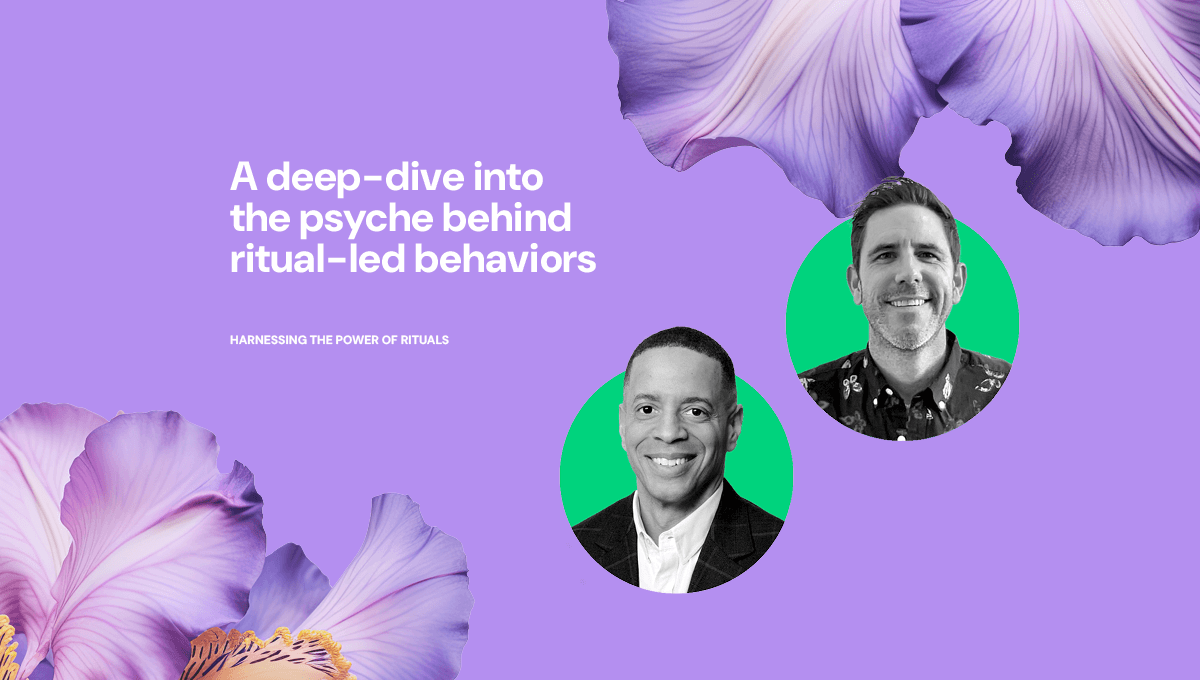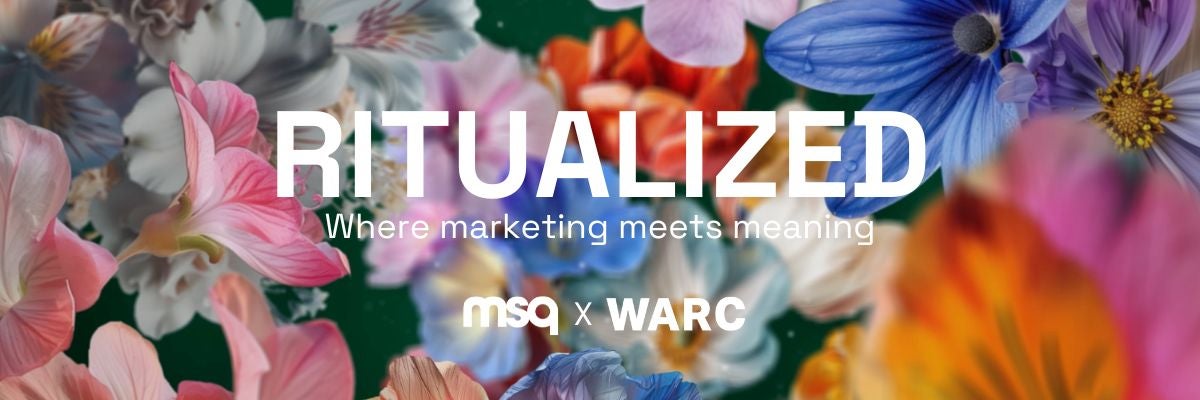 Home Page
Home PageA deep-dive into the psyche behind ritual-led behaviors

As part of our research white paper in partnership with WARC, "Harnessing the Power of Rituals", we spoke to senior marketers across the globe to uncover their own experiences and insights around rituals, and their impact on consumers and brands.
In this interview between Justin Cox, Chief Strategy Officer for MSQ North America and John Starkey, president of Kimberly-Clark's North America Family Care division, John highlights the importance of ritual-led behaviours in building the best campaigns
To download the white paper and discover more about rituals, visit Ritualized.
What is the best consumer insight you’ve come across in your career? Why was it interesting?
I think one of the biggest ones was when I was working on Extra Gum. The brand had relied on the functional benefits of long-lasting flavour for several years. We had to bring innovation to the category and help address the barrier of flavour degradation. It was the downfall of chewing gum at the time.
You weren’t going to win by making the gum last five minutes longer or anything of the sort. When we dug into it and observed the behaviour of people who chewed gum, and the rituals they followed with it, we learned so much. There is a specific behaviour related to chewing gum – using gum as a means of showing care or creating a connection. It taps into the power of creating simple acts of connection and what that can lead to.
It was quite powerful and we tapped into a space that was scary for us in the gum business. It was no longer about the product being the focal point; it was about being part of a human ritual of sharing and creating a connection. The real insight was about the power of those connections and it transformed the Extra Gum brand from being a big brand that everybody knew to a brand that became a loved one.
We did ethnographic studies and everybody would talk about having memories of being a kid in church and their grandmother pulling out a stick of gum, tearing it in half and handing a piece to them. People remember these things but we tend to focus more on the product and the chewing experience and not on the rituals tied to it. Those are the things that create the emotional attachment and are the borrowed memory structures that become pivot points for businesses and brands. They're hard to tap into at times. But when you do it well and make it clear to consumers, it becomes a great avenue for growth.
I'm sure you've seen it from a packaging standpoint. When you think of distinctive memory structures and borrowed memory structures, sometimes it's about capturing that subconscious that is the real mechanism for building an emotional connection with consumers.
Are there any noticeable or remarkable rituals of the category in your business? Are there any rituals that your brand is a part of?
There were a tonne of rituals we were connected to when I was at Danone, primarily because of the products that I worked on. I headed the beverage creation business; we had coffee creamers and ready-to-drink coffee, etc.
Take coffee creamers, for example. There are several rituals around making coffee at home. The business took off during Covid-19 when people were at home. They switched their rituals from going to work and taking that diversion to Starbucks to get coffee for their commute, or stopping before they got on a train. We followed the patterns of what was happening in coffee shops as inspiration for when I worked on oat milk and almond milk and the rituals of people adding these kinds of milk to their coffee. Do you want 2% whole milk? Do you want oat milk or almond milk? There are rituals behind using a certain type of milk, having cold foam or different types of coffee grounds, and so on. These behaviours were fundamental to our understanding of driving velocities both out-of-home and in-home, with the advent of the Keurig coffee machine.
It became an opportunity to avoid the coffee shop during Covid-19. That disruptor helped us figure out how we could bring that same coffee culture into the home. So we launched a cold foam creamer at the beginning of this year. Now you can be your own barista at home, make videos and share across TikTok and YouTube. There is a lot of content, particularly with GenZ and young millennials, who are obsessed with coffee culture and talking about the newest things they’ve found, how they’ve created their own coffee and the like.
How can marketers incorporate these rituals into the messaging, promotion or storytelling itself?
Let’s take our Cottonelle business as an example]. At Cottonelle, we have dry bath tissue and flushable wipes. We are trying to drive a regime in our advertising. We have advertising that specifically talks about using toilet paper and following it up with Cottonelle flushable wipes for a complete and confident clean. We are in the sphere of everyday ritualistic behaviour and trying to shape a specific behaviour within that context.
Are there certain triggers that help consumers grasp the messaging and the ritualistic behaviour you want them to adopt?
I can go back to when I was brand manager of Hamburger Helper. This was several years ago and we did ethnographic studies at the time. The business was in decline, and a part of the challenge was that many of the folks who worked on the brand weren't necessarily the core or target consumers of the brand. Some consumers looked at the product in two different ways: either as the output after you make the meal with Hamburger Helper, or as the product they were purchasing at the shelf - which was salt powder, dry cheese and pasta in a box.
Now think of that mom on a limited budget who is working full time – as is her husband – and who is trying to be the primary caregiver for her family. She struggles with putting a meal on the table every day, a meal that everybody will like and not complain about. I observed my kids when we made it at home; they were thrilled that it was like macaroni and cheese on steroids. It has macaroni and cheese with beef, creamy sauce, noodles and pasta. It’s not something you’re going to get elsewhere.
So the thing to realise was that everybody was going to eat it, picky eaters and all, so we focused on that. It was based on ethnographies and spending a lot of time with the core consumers and hearing about how much they loved it and why they were passionate, regular users of the product.
Though it was a meal they put together in under 30 minutes with the powder and the pasta and the rest of it, the end product was a home-cooked meal that everybody ate. It made these women feel like good moms. Think about all the other things they could try because of this product – they could hide some vegetables in it for their kids. Dinner was a success and it was cost- and time-effective.
Are there micro influences – for example time of day, seasonality or geography – that impact the rituals of your customers or category?
Different seasons play a huge role in various categories. Take Halloween. There’s a lot of permissibility from a chocolate standpoint for this holiday. Then there are advent calendars, which were a big deal, with the role of chocolate and the rituals associated with these. Then also take Easter, with its baskets, and of course then there’s Valentine’s Day.
Contrast this with seasons and symptomology from a Kleenex standpoint and you realise that those are the points of either brand adoption or market entry where you need solutions. If you've got Covid, or if you've got the flu, or if your kid is sick, you know there are certain seasonal periods where your products become more front and centre than others.
What guidelines can help marketers assess the opportunities and risks in commercialising a ritual?
Consumers have their own rituals and unique life stories. If you can highlight where your brand is a part of their story, then you’re not trying to pound into someone's head why they should care about it.
You're reflecting the customer’s rituals and showing exactly how your brand authentically fits into their life. You soon become a no-brainer. Let’s go back to Extra Gum. When we created the ad, which was the story of Sarah and Juan highlighting their relationship and all its firsts, we were tapping into research in terms of the right points of entry. What do young consumers want from gum? Fresher breath, an alternative to brushing? First of all, there’s the ritual of handing a stick of gum to a stranger to start a conversation. Then there’s that first encounter and having the confidence to lean in for your first kiss. Then there’s the first fight of the relationship when you make up with a stick of gum.
And that started the conversation there – it was an emotional aspect of the story where the guy has all the pictures of the entire relationship that he has drawn on a wrapper. He invites her to a restaurant and there’s a wrapper of him being down on one knee with the ring and she turns around and he's there. It's a story of rituals and how your product fits in authentically in somebody’s story.
Are there macro influences – such as world events, trends in consumption habits, media and tech adoption – that impact the rituals of your consumers?
World events have disrupted and transformed many rituals. For example, there was a phase when cereal was huge. It was booming in the late 1980s, and cereal companies were making a lot of money. It wasn’t just about creating a ritual; they hammered the point about a healthy breakfast and partnered with the US government on the food pyramid and the importance of eating a healthy breakfast. They emphasised the role cereal plays in a healthy breakfast.
Over time, technology and data questioned a lot of these claims. People questioned the healthiness of a cereal breakfast with its high sugar content. There have been disruptors like having coffee or milk instead of cereal for breakfast. You had other offerings like cereal bars.
Rituals change. What doesn’t change is the physiological need for energy and the right type of energy in the morning. So the real question is, how do you adapt to understanding what the consumer needs and what has changed in consumers’ lives contextually? How do you deliver on those needs with your products and brands in a way that makes sense?
VISIT THE RITUALIZED HOMEPAGE, HERE

Further reading



